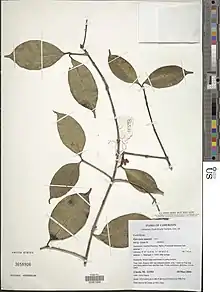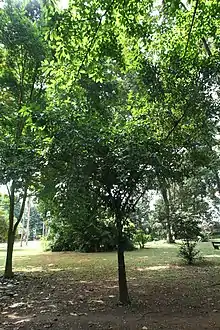Garcinia mannii
Garcinia mannii is a dioecious and evergreen flowering tree in the family Clusiaceae or Guttiferae.[1]
| Garcinia mannii | |
|---|---|
 | |
| Leaves and petioles of the Garcinia mannii tree | |
| Scientific classification | |
| Kingdom: | Plantae |
| Clade: | Tracheophytes |
| Clade: | Angiosperms |
| Clade: | Eudicots |
| Clade: | Rosids |
| Order: | Malpighiales |
| Family: | Clusiaceae |
| Genus: | Garcinia |
| Species: | G. mannii |
| Binomial name | |
| Garcinia mannii Oliv. | |
| Synonyms | |
| |

Distribution
Garcinia mannii is native to southern Guinea and Liberia east to Nigeria and south to Gabon and western Democratic Republic of the Congo. It is introduced in Indonesia.[2]
Description
Its leaves are elliptical in shape and slightly rounded, and the flowers have four red petals with yellow-orange centers. They occur on long stems in clusters of 1-2. Mature trees are often densely branched, with the foliage often concealing the trunk. The branches often appear relatively close to the ground. The bark is brown in color and relatively smooth.[3]
Uses
Due to the chemical composition of the plant, it is used as a chewing stick across its native range.[4]
Taxonomy
The species is named after German botanist Gustav Mann. It was described by botanist Daniel Oliver and has been known since at least 1890.[5] It is not to be confused with Garcinia mannii var. brevipedicellata, a synonym for Garcinia brevipedicellata.
See also
References
- "Garcinia mannii Oliv. | Plants of the World Online | Kew Science". Plants of the World Online. Retrieved 18 January 2021.
- "Garcinia mannii Oliv". www.gbif.org. Retrieved 18 January 2021.
- "Garcinia mannii Oliv". www.gbif.org. Retrieved 18 January 2021.
- "Garcinia livingstonei | PlantZAfrica". pza.sanbi.org. Retrieved 18 January 2021.
- "Garcinia mannii Oliv". www.gbif.org. Retrieved 18 January 2021.